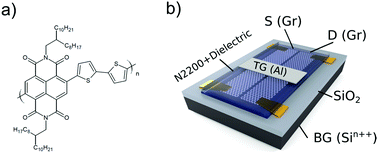Tuning ambipolarity in a polymer field effect transistor using graphene electrodes†
Abstract
Polymer field-effect transistors with 2D graphene electrodes are devices that merge the best of two worlds: on the one hand, the low-cost and processability of organic materials and, on the other hand, the chemical robustness, extreme thinness and flexibility of graphene. Here, we demonstrate the tuning of the ambipolar nature of the semiconductor polymer N2200 from Polyera ActiveInk™ by incorporating graphene electrodes in a transistor geometry. Our devices show a balanced ambipolar behavior with high current ON–OFF ratio and charge carrier mobilities. These effects are caused by both the effective energy barrier modulation and by the weak electric field screening effect at the graphene–polymer interface. Our results provide a strategy to integrate 2D graphene electrodes in ambipolar transistors in order to improve and modulate their characteristics, paving the way for the design of novel organic electronic devices.



 Please wait while we load your content...
Please wait while we load your content...